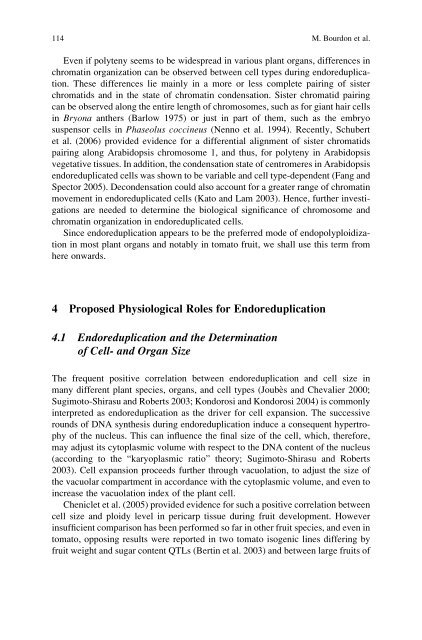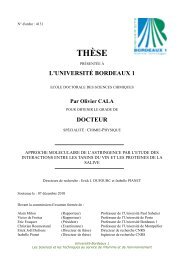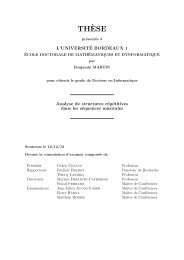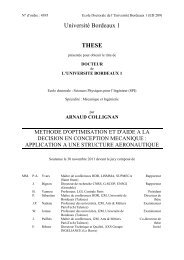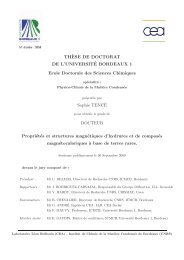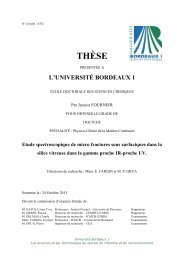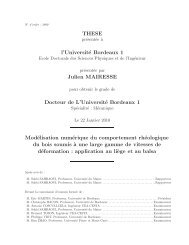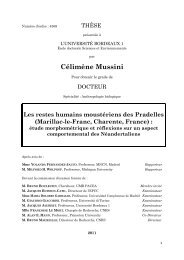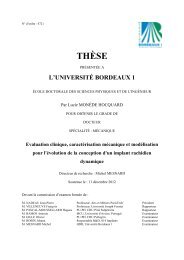de la structure à la croissance cellulaire - Université Bordeaux 1
de la structure à la croissance cellulaire - Université Bordeaux 1
de la structure à la croissance cellulaire - Université Bordeaux 1
You also want an ePaper? Increase the reach of your titles
YUMPU automatically turns print PDFs into web optimized ePapers that Google loves.
114 M. Bourdon et al.<br />
Even if polyteny seems to be wi<strong>de</strong>spread in various p<strong>la</strong>nt organs, differences in<br />
chromatin organization can be observed between cell types during endoreduplication.<br />
These differences lie mainly in a more or less complete pairing of sister<br />
chromatids and in the state of chromatin con<strong>de</strong>nsation. Sister chromatid pairing<br />
can be observed along the entire length of chromosomes, such as for giant hair cells<br />
in Bryona anthers (Barlow 1975) or just in part of them, such as the embryo<br />
suspensor cells in Phaseolus coccineus (Nenno et al. 1994). Recently, Schubert<br />
et al. (2006) provi<strong>de</strong>d evi<strong>de</strong>nce for a differential alignment of sister chromatids<br />
pairing along Arabidopsis chromosome 1, and thus, for polyteny in Arabidopsis<br />
vegetative tissues. In addition, the con<strong>de</strong>nsation state of centromeres in Arabidopsis<br />
endoreduplicated cells was shown to be variable and cell type-<strong>de</strong>pen<strong>de</strong>nt (Fang and<br />
Spector 2005). Decon<strong>de</strong>nsation could also account for a greater range of chromatin<br />
movement in endoreduplicated cells (Kato and Lam 2003). Hence, further investigations<br />
are nee<strong>de</strong>d to <strong>de</strong>termine the biological significance of chromosome and<br />
chromatin organization in endoreduplicated cells.<br />
Since endoreduplication appears to be the preferred mo<strong>de</strong> of endopolyploidization<br />
in most p<strong>la</strong>nt organs and notably in tomato fruit, we shall use this term from<br />
here onwards.<br />
4 Proposed Physiological Roles for Endoreduplication<br />
4.1 Endoreduplication and the Determination<br />
of Cell- and Organ Size<br />
The frequent positive corre<strong>la</strong>tion between endoreduplication and cell size in<br />
many different p<strong>la</strong>nt species, organs, and cell types (Joubès and Chevalier 2000;<br />
Sugimoto-Shirasu and Roberts 2003; Kondorosi and Kondorosi 2004) is commonly<br />
interpreted as endoreduplication as the driver for cell expansion. The successive<br />
rounds of DNA synthesis during endoreduplication induce a consequent hypertrophy<br />
of the nucleus. This can influence the final size of the cell, which, therefore,<br />
may adjust its cytop<strong>la</strong>smic volume with respect to the DNA content of the nucleus<br />
(according to the “karyop<strong>la</strong>smic ratio” theory; Sugimoto-Shirasu and Roberts<br />
2003). Cell expansion proceeds further through vacuo<strong>la</strong>tion, to adjust the size of<br />
the vacuo<strong>la</strong>r compartment in accordance with the cytop<strong>la</strong>smic volume, and even to<br />
increase the vacuo<strong>la</strong>tion in<strong>de</strong>x of the p<strong>la</strong>nt cell.<br />
Cheniclet et al. (2005) provi<strong>de</strong>d evi<strong>de</strong>nce for such a positive corre<strong>la</strong>tion between<br />
cell size and ploidy level in pericarp tissue during fruit <strong>de</strong>velopment. However<br />
insufficient comparison has been performed so far in other fruit species, and even in<br />
tomato, opposing results were reported in two tomato isogenic lines differing by<br />
fruit weight and sugar content QTLs (Bertin et al. 2003) and between <strong>la</strong>rge fruits of


